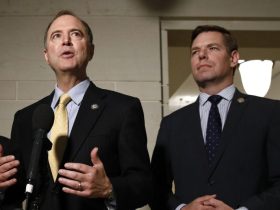The third night of the 2024 Democratic National Convention in Chicago featured more mostly thematic speeches, including by former president Bill Clinton, House Democratic leader Hakeem Jeffries and vice-presidential nominee Tim Walz. Here are four claims that caught our attention, in the order in which they were made.
As is our practice, we do not award Pinocchios for a roundup of statements made during convention events.
“Page 451 says the only legitimate family is a married mother and father where only the father works.”
— Colorado Gov. Jared Polis
It’s a matter of interpretation. Polis was one of several speakers during the convention who have highlighted passages in a Heritage Foundation report called “Mandate for Leadership,” a 922-page catalogue of conservative proposals that is popularly known as Project 2025.
But the report’s Page 451 does not use the words that Polis suggested he was quoting, nor does it say that mothers should not work. On that page is a proposal for the Department of Health and Human Services to promote “stable and flourishing married families.”
“Families comprised of a married mother, father, and their children are the foundation of a well-ordered nation and healthy society,” the report says, accusing the Biden HHS of “agenda items focusing on ‘LGBTQ+ equity,’ subsidizing single-motherhood, disincentivizing work, and penalizing marriage.”
The report also says that “working fathers are essential to the well-being and development of their children, but the United States is experiencing a crisis of fatherlessness that is ruining our children’s futures.” To combat this trend, the report says, “HHS should prioritize married father engagement in its messaging, health, and welfare policies.”
While Page 451 doesn’t actually say that the “only legitimate family” is the one it defines here, the implication is nonetheless strong. (Project 2025 page-number callouts in a skit by comedian Kenan Thompson mostly described the proposals on those pages accurately.)
“Trump was the mastermind of the GOP tax scam, where 83 percent of the benefits went to the wealthiest 1 percent in America.”
— House Minority Leader Hakeem Jeffries (D-N.Y.)
This is mostly false. Jeffries loves this statistic, but we gave him Three Pinocchios for it in 2021.
When both the Joint Tax Committee and the Tax Policy Center looked at the impact of the 2017 tax bill, they concluded that most people would experience an overall reduction in taxes. The Tax Policy Center found that 80.4 percent of all taxpayers would have a tax cut, compared with about 5 percent experiencing a tax increase. In the middle quintile, 91 percent would get a tax cut, averaging about $1,090, with 7.3 percent facing a tax increase averaging about $910.
Notice how Jeffries said that 83 percent “went” to the top 1 percent? He’s speaking in the past tense. But he’s relying on data for the year 2027 — three years from now — that is distorted by a decision made by the Republican tax-writers when crafting the bill.
Technically, under the budget rules agreed by Congress, the tax bill was supposed to increase the budget deficit by only $1.5 trillion over 10 years. But there was too much pressure to add in as many tax goodies as possible, so Republicans decided to allow significant provisions, such as individual tax cuts, to expire a couple of years before the end of the period budgeted for the tax cut.
This budget gamesmanship means that the tax tables for 2027 are distorted. The corporate tax cuts stay intact, but virtually all of the tax cuts for individuals were canceled, as Republicans bet that political pressure to keep the individual tax cuts in place would force a future Congress to extend them.
That may or may not have been a good wager. But politically it gave the Democrats a useful (if misleading) talking point. The 2027 tax tables produced by the Tax Policy Center show 82.8 percent of the tax cuts will flow to the top 1 percent. These numbers would be fine to cite in 2027, assuming the tax cuts expired on schedule. But it makes little sense to use them now.
“Since the end of the Cold War in 1989, America has created about 51 million new jobs. I swear I checked this three times. Even I couldn’t believe it. What’s the score? Democrats 50, Republicans 1.”
— Former president Bill Clinton
This is a cleverly cherry-picked fact. Clinton starts with the end of the Cold War, presumably the fall of the Berlin Wall on Nov. 9, 1989, which (economically speaking) is somewhat arbitrary. Economic trends such as job growth are not determined by presidential terms but often economic forces beyond a president’s control.
Bureau of Labor Statistics data show that nearly 50 million jobs were created from November 1989 through July of this year.
By starting during George H.W. Bush’s term, Clinton skips over Ronald Reagan, a Republican who oversaw the creation of 16 million jobs. Instead, the period covered by his statistic included three Republicans — Bush, his son George W. Bush and Trump — who had poor jobs records. About 1 million jobs were created from November 1989 to the end of the first Bush term, 1.4 million under his son, and then a negative 2.7 million under Trump (because of the pandemic). All three Republicans ended their terms with the country in economic downturns.
By contrast, 22.9 million jobs were created under Clinton, 11.6 million under Barack Obama and 15.8 million under President Joe Biden.
You will note that gives the Democrats 50.3 million jobs and the Republicans a negative 300,000. Perhaps Clinton thought that would sound too fantastical. So it appears as if he dated his statistic from January 1989, which results in a total of 51.5 million jobs, with about 1.3 million for Republicans.
“They’ll repeal the Affordable Care Act. They’ll gut Social Security and Medicare, and they will ban abortion across this country with or without Congress.”
— Vice-presidential nominee Tim Walz
This is speculative. Trump has insisted he will not touch Social Security or Medicare — and he largely kept to that pledge during his presidency.
He tried repeatedly to repeal the Affordable Care Act when he was president, but failed. After he announced he would seek the presidency again, Trump suggested again he would seek to repeal the health-care law passed in Obama’s presidency. But the ACA remains popular, and Trump dropped that talking point more than a year ago.
As for abortion, Trump has said the Supreme Court sent the matter to the states and that each state can set its own policies. But many conservative allies are eager to restrict abortion rights even further, perhaps using old laws on the books (such as the Comstock Act of 1873) in new and aggressive ways. Walz hinted at that by saying Trump would act “with or without Congress.”
(About our rating scale)
Send us facts to check by filling out this form
Sign up for The Fact Checker weekly newsletter
The Fact Checker is a verified signatory to the International Fact-Checking Network code of principles








